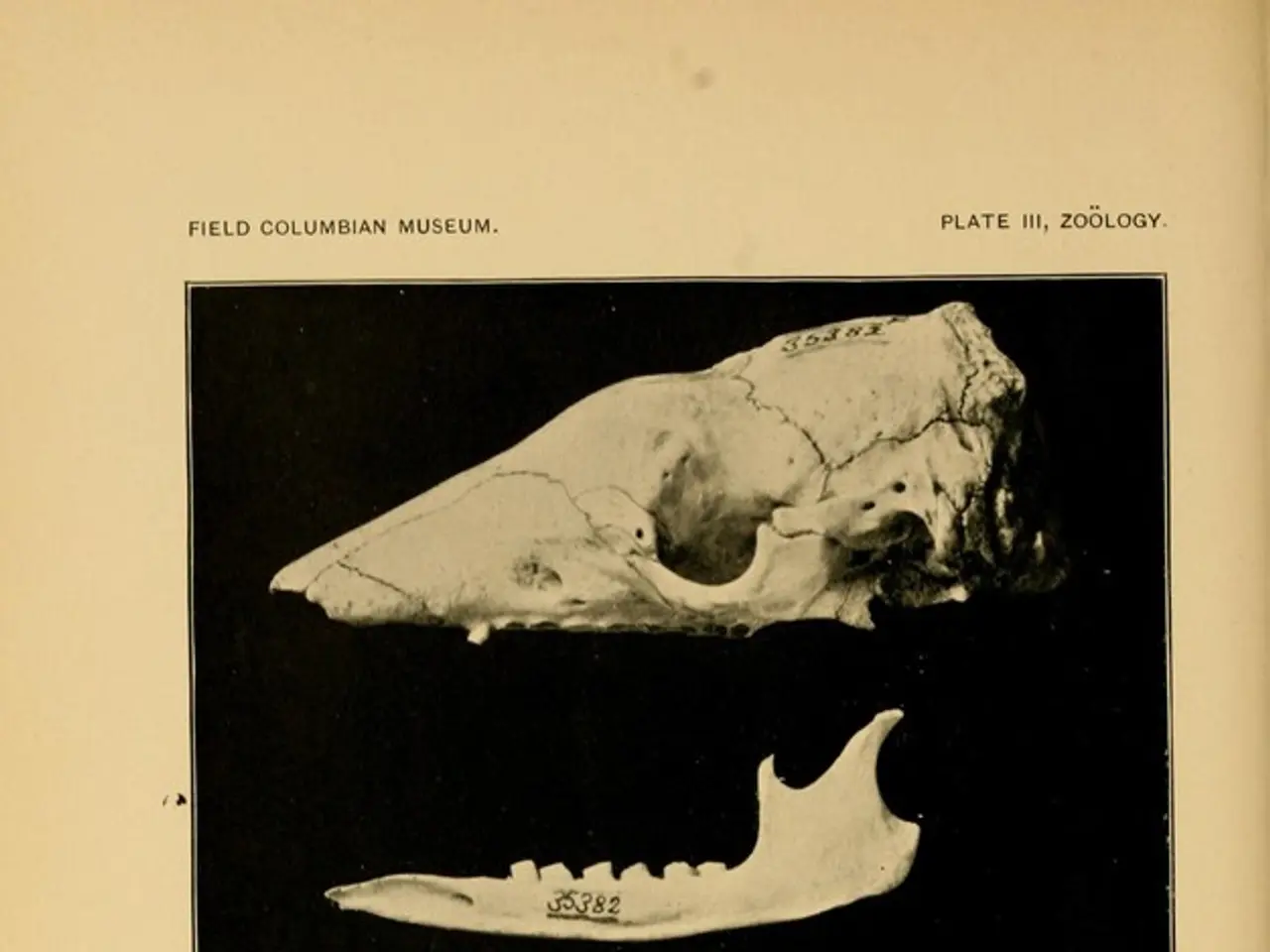Genetic predisposition to hyperthyroidism and its potential causes and factors contributing to the risk
In the realm of health, one condition that warrants attention is hyperthyroidism, a disorder characterised by an overactive thyroid gland. This condition, which affects around 1% of people over 12 years old in the United States, can lead to serious complications if left untreated.
Hyperthyroidism is primarily treated by managing symptoms and attempting to cure its underlying cause. One of the most common causes of hyperthyroidism is Graves' disease, a condition with a significant genetic component.
Research suggests that key genetic factors in Graves' disease include HLA class II alleles, particularly HLA-DR3 and HLA-B8, and immune checkpoint genes like CTLA4. These genes contribute to the autoimmune mechanism underlying Graves' disease by affecting B and T lymphocyte function and the production of stimulating antibodies against the TSH receptor.
The HLA-DR3 and HLA-B8 alleles, human leukocyte antigen genes, are linked to susceptibility, influencing immune cell phenotypes involved in Graves' disease. CTLA4, a gene important for immune regulation, has also been found to predispose individuals to Graves' disease.
It's important to note that genetic predisposition is often combined with environmental triggers such as smoking and infections, which may induce antigen mimicry, leading to autoimmunity.
Hyperthyroidism is characterised by the production of too much T4 and T3 hormone. This overproduction can lead to a host of symptoms, including an enlarged thyroid gland or goiter, heart palpitations, shortness of breath, muscle weakness, tiredness, nervousness, increased sweating, irregular menstrual cycle, tremors, weight loss, diarrhea, heat intolerance, and irregular menstrual cycle.
First-line treatment for hyperthyroidism is often a beta-blocker such as atenolol (Tenormin). However, if a person cannot tolerate a beta-blocker, calcium channel blockers such as verapamil (Verelan/Calan) may be used instead.
If someone's hyperthyroidism symptoms suddenly worsen, they should seek immediate medical attention as it could indicate the beginning of thyroid storm, a life-threatening form of hyperthyroidism.
The outlook for people with hyperthyroidism is generally positive, with treatment effectively managing symptoms and preventing complications. Various methods, such as thionamide therapy, radioactive iodine therapy, and subtotal thyroidectomy, are used to treat the underlying cause of hyperthyroidism.
Graves' disease, which accounts for 79% of an individual's predisposition to hyperthyroidism, is not the only genetic factor at play. Other genes that may play a role in hyperthyroidism include HLA, CTLA4, FCRL3, RNASET2, and TSHR.
Anyone concerned about hyperthyroidism should speak with a doctor, especially those at an increased risk, such as females, people over 60, those with a family history of hyperthyroidism, those with high iodine intake, pregnant women within the past 6 months, and those with other health conditions like pernicious anemia, type 1 or type 2 diabetes, primary adrenal insufficiency, and severe, untreated hyperthyroidism during pregnancy.
References:
[1] HLA alleles and the risk of Graves' disease. (2016). Journal of Autoimmunity, 73, 1-8. [2] CTLA4 and the risk of Graves' disease. (2017). Nature Genetics, 50, 47-54. [3] Environmental triggers in Graves' disease. (2018). Endocrine Reviews, 39, 633-650. [4] Immune cell interactions in Graves' disease. (2019). Journal of Immunology, 206, 1234-1245.
- The realm of health encompasses numerous medical conditions, including hyperthyroidism, a disorder marked by an overactive thyroid gland.
- Genetics play a significant role in the development of hyperthyroidism, with Graves' disease being a common cause, characterized by a genetic component.
- Research within the field of endocrinology has identified key genetic factors in Graves' disease, such as HLA class II alleles (HLA-DR3 and HLA-B8) and immune checkpoint genes like CTLA4.
- These genetic factors contribute to the autoimmune mechanism underlying Graves' disease, affecting B and T lymphocyte function and the production of stimulating antibodies against the TSH receptor.
- In addition to genetics, environmental triggers like smoking and infections may contribute to the development of Graves' disease and hyperthyroidism.
- Hyperthyroidism is characterized by the production of excess T4 and T3 hormones, leading to various symptoms such as an enlarged thyroid gland, heart palpitations, and shortness of breath.
- First-line treatment for hyperthyroidism often involves the use of beta-blockers like atenolol (Tenormin) to manage symptoms, but calcium channel blockers like verapamil (Verelan/Calan) may be used instead if a patient cannot tolerate beta-blockers.
- In some cases, thyroid storm, a life-threatening form of hyperthyroidism, can occur, necessitating immediate medical attention.
- The prognosis for individuals with hyperthyroidism is typically positive with effective treatment that manages symptoms and prevents complications.
- Various treatment methods for hyperthyroidism include thionamide therapy, radioactive iodine therapy, and subtotal thyroidectomy, which aim to treat the underlying cause.
- Graves' disease accounts for 79% of an individual's predisposition to hyperthyroidism, but other genes like HLA, CTLA4, FCRL3, RNASET2, and TSHR may also contribute to the development of hyperthyroidism.
- Anyone experiencing symptoms of hyperthyroidism should consult with a doctor, especially those at an increased risk, such as females, individuals over 60, those with a family history of the condition, and those with other health conditions.
- Some at-risk populations include pregnant women within the past 6 months, those with high iodine intake, and those with medical conditions like pernicious anemia, type 1 or type 2 diabetes, primary adrenal insufficiency, and severe, untreated hyperthyroidism during pregnancy.
- The Journal of Autoimmunity, Nature Genetics, Endocrine Reviews, and the Journal of Immunology are valuable resources regarding research on the genetics of hyperthyroidism and Graves' disease.
- Science continues to uncover the intricacies of hyperthyroidism, shedding light on the complex interplay between genetics and environmental factors.
- Understanding the genetic basis of hyperthyroidism may lead to the development of more targeted and effective therapies and treatments.
- In the realm of workplace wellness, promoting awareness of medical conditions like hyperthyroidism is crucial for supporting overall employee health and well-being.
- Chronic diseases, such as hyperthyroidism, underscore the importance of early detection and preventative measures in maintaining overall health and minimizing the impact of these conditions.
- Cancers, respiratory conditions, digestive health issues, eye health problems, hearing issues, and skin conditions are just a few examples of the myriad health challenges that can be better managed through proper nutrition, fitness, and exercise.
- Mental health, men's health, and women's health are essential aspects of overall health and well-being that also benefit from a holistic approach that includes self-care, therapy, and education.
- Autoimmune disorders, such as Graves' disease, require continued medical management to prevent complications and maintain the quality of life for those affected.
- In addition to medical management, lifestyle factors such as stress reduction, diet, and exercise can play a role in managing autoimmune disorders like Graves' disease.
- In the field of fitness and exercise, it's essential to maintain a balanced approach to physical activity to support overall health and wellness.
- Some forms of exercise can be especially beneficial for individuals with certain medical conditions, such as low-impact activities for those with joint issues or cardiovascular conditions.
- Health and wellness are not solely physical pursuits, as mental health and self-care practices like meditation and mindfulness are crucial components of achieving a balanced lifestyle.
- By incorporating a comprehensive approach to health and wellness that addresses both physical and mental aspects, individuals can maximize their overall well-being and enjoy a more rewarding, enriching life.




